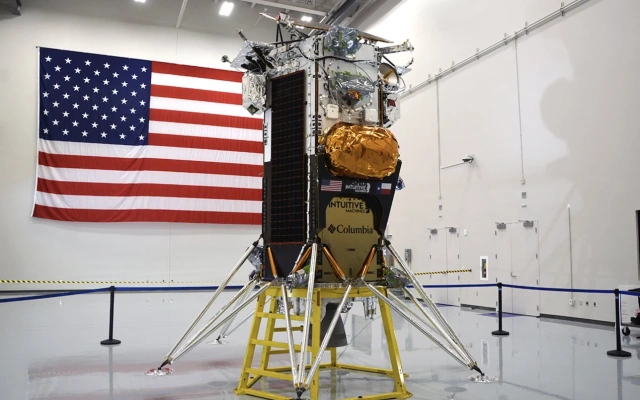There are enormous frozen water accumulations at the Moon’s South Pole. Odyssey, the first-ever private lunar module, was sent there to investigate this area. We describe the type of equipment and its necessity.
Lunar module “Odyssey”: what kind of device is it
Nova-C, or Odyssey, is a private lunar lander from Houston-based Intuitive Machines. It is a hexagonal cylinder with six landing pads. Its height is 4 m, width is 1.57 m and its weight is 1908 kg. Nova-C can deliver about 100 kg of payload to the lunar surface. The mission that sent Odyssey to the Moon is called IM-1.
Why was the lunar module Odyssey launched?
Odyssey is one of the landers that NASA will launch in 2024 to prepare for manned flights as part of the Artemis program. These devices are designed to deliver cargo to the Moon that will be needed by expedition participants. From 2025, the agency plans to send people to the Earth’s satellite (first it should be a manned flight and in the future – landing).
For the module to operate successfully, it was equipped with six NASA scientific instruments included in the Commercial Lunar Payload Services (CLPS) program. It aims to use privately owned spacecraft to collect data that will pave the way for a permanent human presence on and around the Moon.
For example, the module is equipped with a laser retroreflector that helps other spacecraft make precise landings. This radio navigation beacon provides geolocation data to landers and astronauts, stereo cameras, and an apparatus for studying gas on the lunar surface.
What were the launch, flight, and landing like?
The launch was planned for February 14 but was postponed a day due to environmental conditions. The module was launched from Cape Canaveral. The device was delivered into space by a SpaceX Falcon 9 rocket. Its first stage successfully landed back on Earth.
Odyssey entered lunar orbit on February 21 and reached the surface of the satellite on February 23. The device landed 1.5 km from the intended target – the Malapert A crater, 300 km from the South Pole. However, the module flew too fast and caught on the surface of the satellite during the landing.
It was planned that the device would work on the Moon for 14 Earth days – until the onset of a long cold period, which the module was unable to survive. However, due to an unsuccessful landing, the process ended early. The device landed on its side and stopped working as soon as the light stopped hitting the solar panels.
At the same time, the rest of the equipment and payload worked normally, – researchers from Earth managed to obtain an array of data. What will happen next with the device is still unknown.
The Odyssey, in addition to scientific instruments, transported payloads from six private companies to the Earth’s satellite. Here’s what’s left on the Moon:
- Columbia’s Omni-Heat Infinity aerospace heat-reflective material;
- the EagleCam camera system from Embry Riddle Aeronautical University;
- a sculpture by artist Jeff Koons of 125 miniature stainless steel moon phases;
- the ILO-X device to create an observatory at the satellite’s South Pole;
- monograms from the Galactic Heritage Laboratory with data from cultural archives and Wikipedia entries;
digital media for the first data bank on the Moon from Lonestar data holdings.
Nova-C became the first private lunar lander in history and the first US spacecraft on Earth’s satellite since 1972.
Prospects
Intuitive Machines received $77 million for three missions to land unmanned vehicles on the Moon as part of NASA’s program. All of them require the use of Nova-C modules. The company is already working on preparing a second flight. The new device will carry other payloads.
So, they are going to send a small autonomous robot “Hopper” on its next flight. It will detach from the lander and descend into permanently shadowed areas inside lunar craters, study them, and then return. Sunlight never reaches its bottom, and the material accumulated there may contain new information about our solar system.


